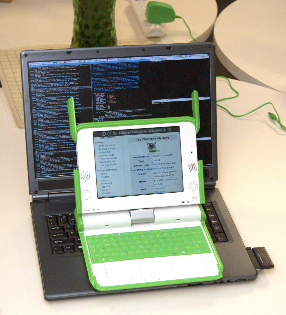Emulating the XO/lang-ja
- This is an on-going translation
{{anchor|Quick Start - [[LiveCd|LiveCD]}}
Quick Start - LiveCD
For many, the LiveCD is the easiest way to try Sugar. It's easy to do, but your work is lost when you reboot.
As of July 2007, the Live CD hasn't been updated in more than 3 months. The software has advanced greatly during that time, so it's not clear the Live CD is of much use until it gets updated.
Quick Start - Emulation
Emulation is the other way to try Sugar. It can be harder to set up,, but work is preserved.
- Sound in TamTam may not be working at the moment. MitchellNCharity 13:16, 5 June 2007 (EDT)
Quick Start for Developers
Developing on emulation is one alternative for developing software.
Get the latest image from here. (add link to tinderbox) Install QEMU and kernel acceleration as described in Emulating the XO/Quick Start. See the /Help_and_tips "Development" section.
505 is the most recent build known to work. Builds after 541 run, but collaboration is broken (you can't see other laptops).
Many builds between 541 and 505, including 531, 529, and 525, didn't boot. However, some of the later 50x may work.
Overview
One way to run oplc software is using an emulator on your pc. See Getting started programming for other options.
Note Category:Emulation and Help and tips.
For play, you can use LiveCd or Quick Start.
For development, you can use LiveCd, or qemu (as in quick start, but with a different image), or perhaps one of the Developer Images other than the LiveCd. An alternate approach is to attempt installing sugar. See Getting started programming for a comparison.
A common development approach is to use QEMU with kqemu acceleration. See Quick Start for the basics. Though for development, we will use a different .img, one with a few extra utility programs. See OS images, including latest stable build.
Instead of qemu, you can run VMware, and there are additional options on a Mac.
Please report your experiences in User Feedback on Images. There is a Virtualization Common Room.
There are limitations with XO disk images.
The LATEST-STABLE-BUILD versus LATEST build distinction is mostly of interest to people running on actual XO's. In emulation, developers should usually use LATEST. And when STABLE is old, non-developers probably should too.
Comparison of alternatives
An OLPC laptop is custom hardware, running a stripped-down Red Hat linux, running Sugar. But what if you don't have a real olpc laptop? There are a several options, which can each be used in a couple of ways.
recommendations
background
Example step-by-step instructions
echo $COOKIE
3. On the xo, still as "su olpc", record the cookie: (First time only)
echo "add 10.0.2.2:1 . " PUT-THE-COOKIE-HERE
Links
- Tutorial Written by IBM on how to get this working.
